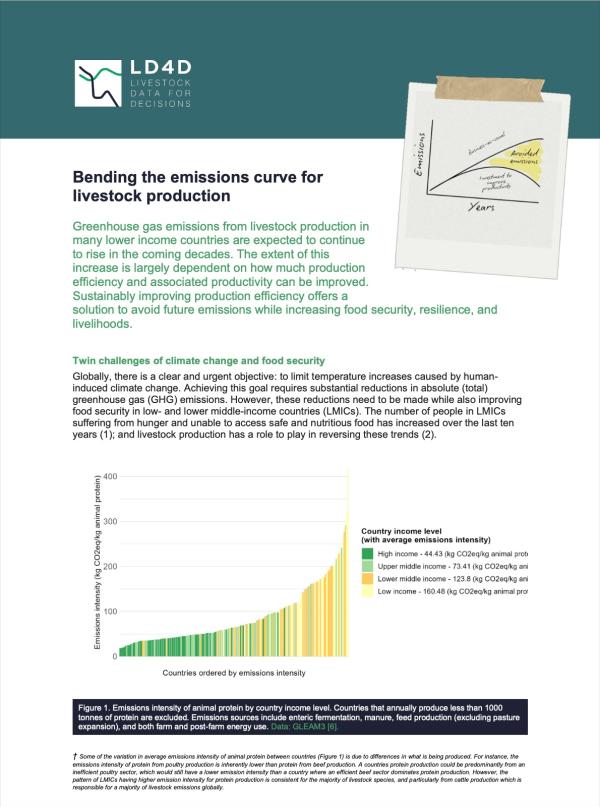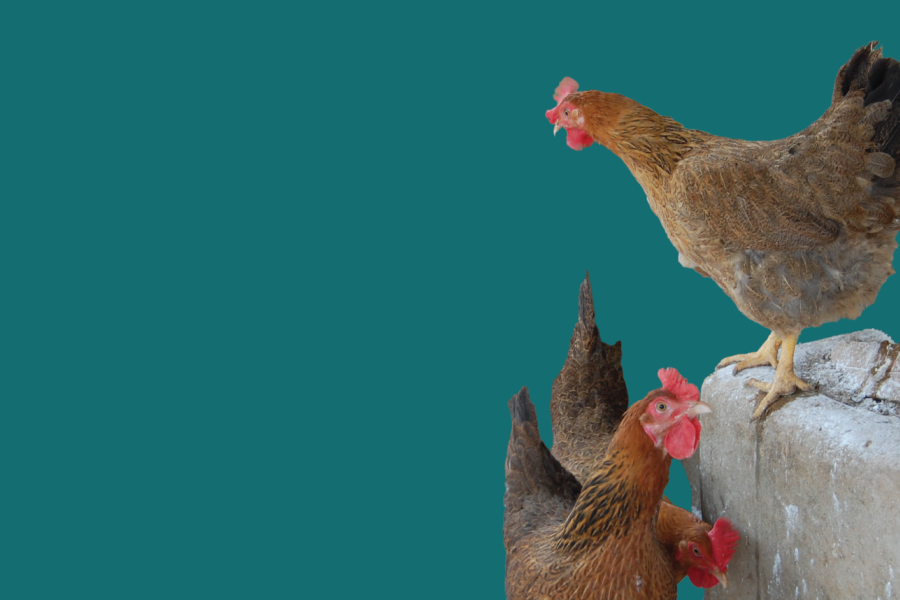Bending the emissions curve for livestock production
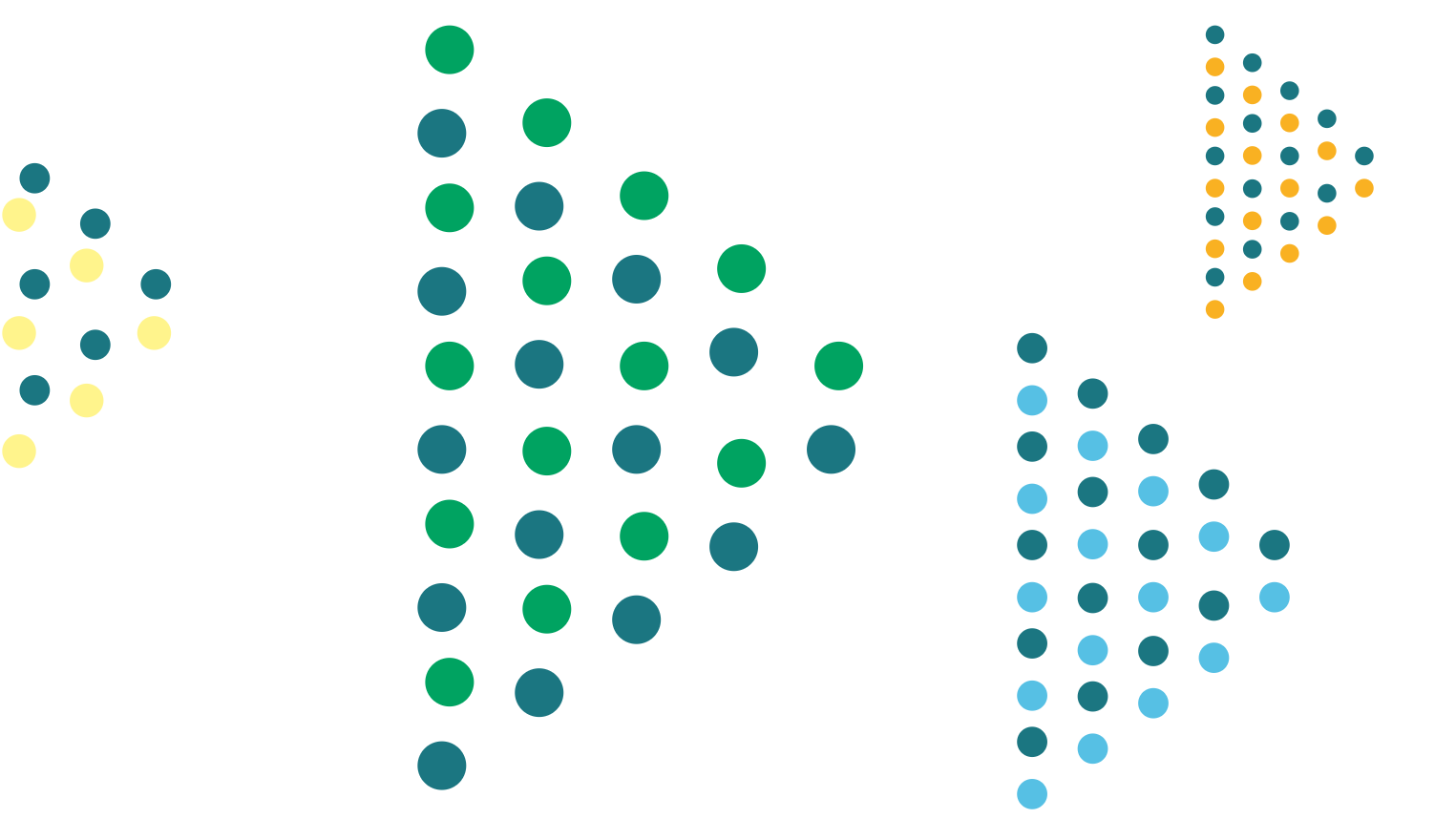
Citation
Greenhouse gas emissions from livestock production in many lower income countries are expected to continue to rise in the coming decades. The extent of this increase is largely dependent on how much production efficiency and associated productivity can be improved. Sustainably improving production efficiency offers a solution to avoid future emissions while increasing food security, resilience, and livelihoods.
Twin challenges of climate change and food security
Globally, there is a clear and urgent objective: to limit temperature increases caused by human-induced climate change. Achieving this goal requires substantial reductions in absolute (total) greenhouse gas (GHG) emissions. However, these reductions need to be made while also improving food security in low- and lower middle-income countries (LMICs). The number of people in LMICs suffering from hunger and unable to access safe and nutritious food has increased over the last ten years (1); and livestock production has a role to play in reversing these trends (2).
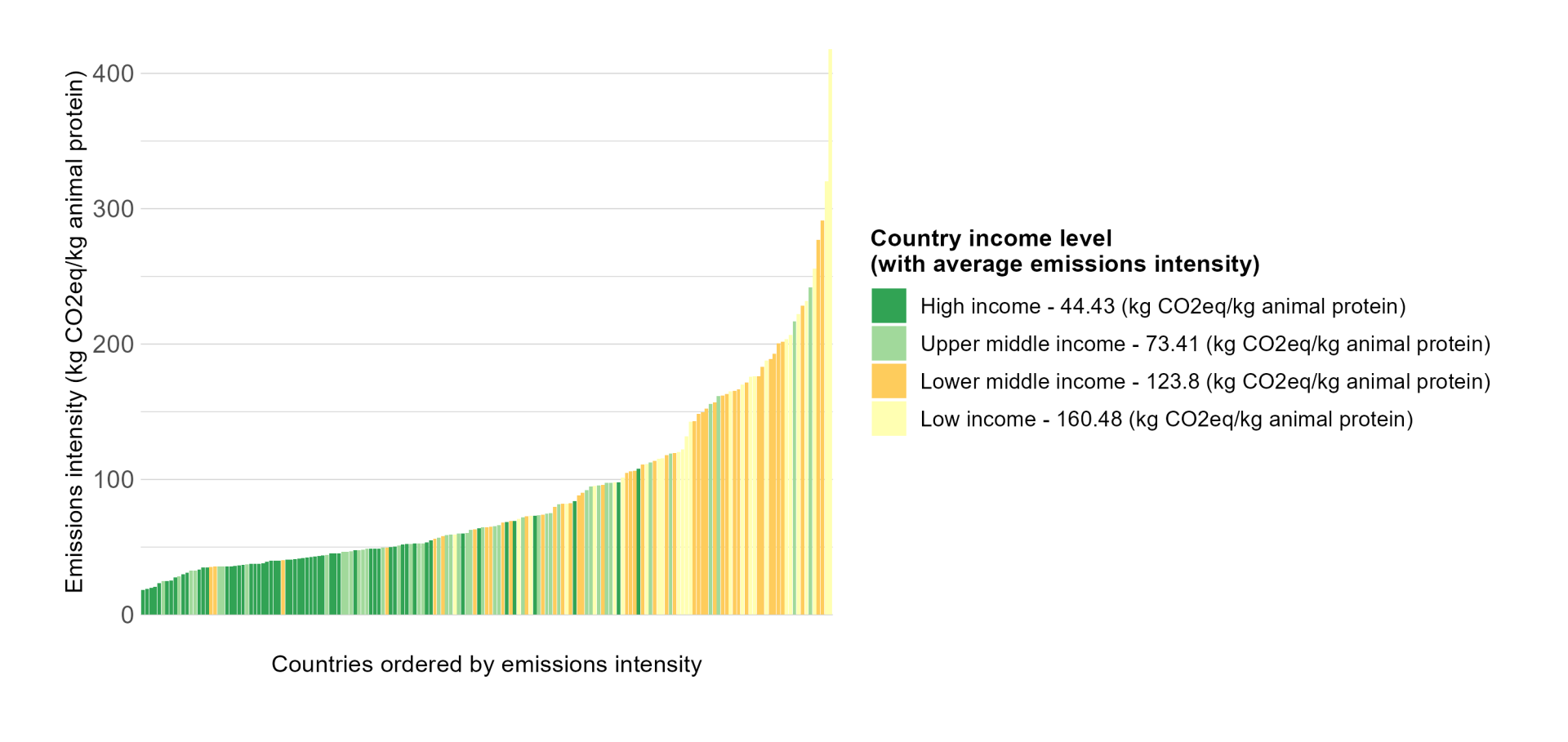
Figure 1. Emissions intensity of animal protein by country income level. Countries that annually produce less than 1000 tonnes of protein are excluded. Emissions sources include enteric fermentation, manure, feed production (excluding pasture expansion), and both farm and post-farm energy use. Data: GLEAM3 [6].
†Some of the variation in average emissions intensity of animal protein between countries (Figure 1) is due to differences in what is being produced. For instance, the emissions intensity of protein from poultry production is inherently lower than protein from beef production. A countries protein production could be predominantly from an inefficient poultry sector, which would still have a lower emission intensity than a country where an efficient beef sector dominates protein production. However, the pattern of LMICs having higher emission intensity for protein production is consistent for the majority of livestock species, and particularly from cattle production which is responsible for a majority of livestock emissions globally.
An increasing demand for livestock production in emerging economies
The demand for animal sourced foods in LMICs is predicted to increase over the coming decades, driven mainly by human population growth, increased incomes and urbanisation. Between 2020 and 2050, demand is predicted to increase more than 100% in Africa, the continent with the highest concentration of LMICs (3,4,5). Presently, LMICs produce about one-fifth of total global animal protein and contribute around one-third of total annual livestock sector GHG emissions (6). However, LMIC livestock production efficiency and productivity are generally low, with suboptimal use of resources and a high input to output ratio. This results in higher emissions intensity (quantity of GHG emissions produced per unit of product) when compared to higher-income countries (Figure 1)†.
At a farm level, inadequate animal nutrition regularly limits production. Feeds are often of poor quality or insufficient quantity, there is limited access to supplements, and pastures are often overgrazed and degraded. The genetic makeup of a large proportion of animals limits their production potentials. Disease and harsh environmental conditions further reduce both production and reproduction efficiency by reducing livestock performance (higher death rates, yield reductions, and reduced fertility) while forcing livestock keepers to focus on maintaining resilience rather than becoming more resource efficient and productive. This reality is worsened by the increasing impacts of climate change.
The response of the livestock sector
Theoretically, the livestock sector in LMICs could respond to the increasing demand in one of two ways. These are illustrated as two contrasting future scenarios in Figure 2. The first is a business-as-usual scenario, where there is limited investment in improving production efficiency and productivity: these improve only marginally through a continuation of existing efforts and initiatives. A greater number of animals will be required to increase production to meet rapidly rising demand. There will be limited change to the emissions intensity of animal sourced foods in LMICs, so absolute emissions will continue to increase in line with demand.
In the alternative scenario, increased investment is made into sustainably improving production efficiency and productivity. Resource use is increasingly optimised, and the inputs required per unit of output are reduced. Animal numbers do not need to increase as much to meet increasing demand. In simple terms, if you have cows that produce a higher yield of milk or meat and they are given inputs required to reach those production potentials, you need fewer of them (in contrast to low yielding cows) to produce increasing quantities of milk or meat in response to increasing demand. Under this scenario, total GHG emissions will likely still increase in the short-term, but because emissions intensity is reduced, the increase will be less than in the business-as-usual scenario. Once demand is met, if production efficiencies are maintained, there is potential to reduce total livestock numbers. Less animals means less direct emissions such as from enteric fermentation and less indirect emissions such as from feed production and land use change. The difference in absolute emissions between these two scenarios (the green shaded area in figure 2) represents the opportunity to avoid GHG emissions.
How to sustainably improve livestock production efficiency and productivity
There are proven existing solutions to improve production efficiency in LMICs.
Livestock feed & nutrition, including pasture and rangeland management, can be improved to support animals to reach and maintain their genetic potentials for production.
Improving animal health can provide co-benefits through reduced death rates and production burdens, improved herd structure, production efficiency, and climate resilience.
The selection of animal breeds with high yield potentials must be balanced with the retention of genetic traits for resilience required for challenging environmental conditions. As well as the maintenance of population genetic diversity to face future challenges.
These solutions require investment to make sure they are fit-for-purpose in LMICs and are therefore adopted by livestock producers and scalable.

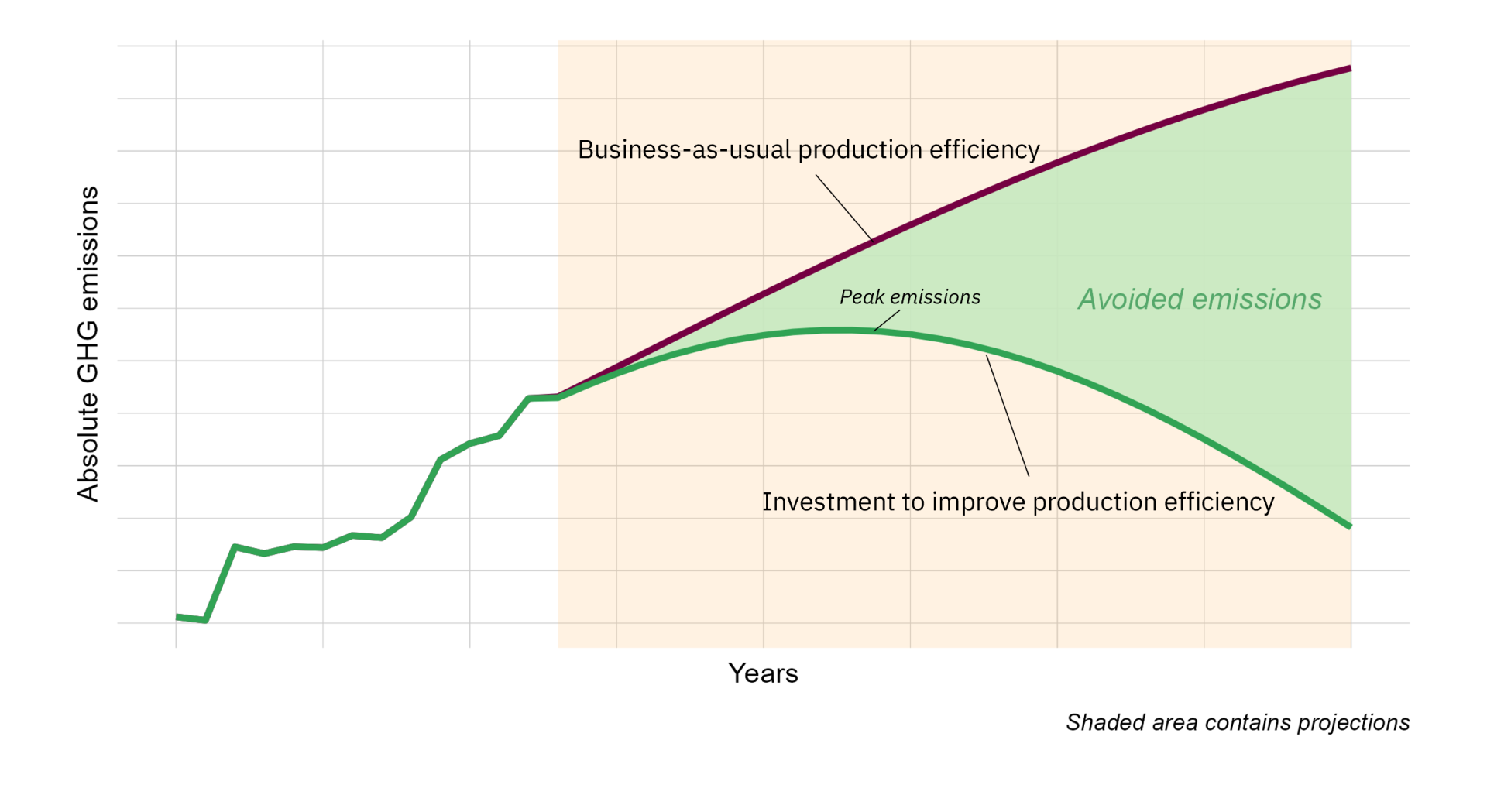
Figure 2. To understand the potential for avoided emissions, or bending the emissions curve, we must consider two alternative scenarios for the future of livestock production in LMICs. One where production efficiency does not improve significantly and one where investment leads to improvement. The difference in absolute emissions between these two scenarios is the potential for avoided emissions (green area).
The multi-functionality of livestock in LMICs
Livestock in LMICs are often not just reared to produce protein; other functions include traction power for crop systems and as a form of savings or insurance. Livestock also carry important cultural values and impart status to their owners in many communities. Interventions focused on improving production efficiency must not ignore these additional socio-economic contributions, nor should they reduce the resilience or adaptation potential of future production systems. Given these varying functions of livestock in LMICs and the environmental limitations that many production systems operate within, it is not expected that LMIC countries can reduce their emissions intensities to match higher-income countries. However, there exists significant variation in the emissions intensity within similar production systems, with similar constraints. This illustrates an addressable productivity gap, and highlights that there is realistic potential for change (improved production efficiency and reduced emissions intensity) [3].
The toolbox of production efficiency improving interventions is well developed and evidence-based. If implemented appropriately, these interventions can offer cost effective opportunities to avoid future GHG emissions, while also supporting delivery of productivity enhancement co-benefits of livestock systems, such as improved human nutrition and better, more resilient livelihoods.
Conclusion
The purpose of this brief is to demystify and illustrate the bending the emission curve concept for decision makers challenged with the apparent trade-offs of reducing climate change impacts and increasing food production for growing populations. These twin challenges cannot be considered in isolation. Production of animal source foods must sustainably increase to meet the demand that is forecasted to increase over the next 25 years. The levels of production efficiency by which this demand is met contributes significantly to total sector GHG emissions. By comparing future business-as-usual scenarios with alternatives, where investment improves long term production efficiency of LMIC livestock systems, emission curves can help communicate and project future emissions, and assist decision makers in understanding the return on investment in terms of avoiding future GHG emissions.
Strategies that seek to bend emission curves provide a pragmatic future direction for LMIC livestock sectors, around which stakeholders with different perspectives can align, track progress, and hold each other mutually accountable.
LD4D produced a series of briefs to unlock climate finance for livestock development.
These include an overview of the tools and insights needed to:
- Quantify emissions
- Build compelling investment cases, and
- Include livestock development in national climate strategies
Case studies highlight how countries and projects have accessed climate finance investment following the "bending the emissions curve" logic of improving productivity to reduce emission intensity.
References
- FAO, IFAD, UNICEF, WFP and WHO. 2024. The State of Food Security and Nutrition in the World 2024 – Financing to end hunger, food insecurity and malnutrition in all its forms. Rome. https://doi.org/10.4060/cd1254en
- FAO, 2024. Ruane, J. and Lucio Restrepo, M., eds. 2024. FAO Global Conference on Sustainable Livestock Transformation – 25-27 September 2023. FAO Animal Production and Health Proceedings, No. 21. Rome, FAO. https://doi.org/10.4060/cd1274en
- FAO. 2023. Pathways towards lower emissions – A global assessment of the greenhouse gas emissions and mitigation options from livestock agrifood systems. Rome. https://doi.org/10.4060/cc9029en
- FAO. 2018. The future of food and agriculture – Alternative pathways to 2050. Rome. 224 pp. Licence: CC BY-NC-SA 3.0 IGO. ISBN 978-92-5-130158-6
- The World Bank. 2025. The World by Income and Region. Available at: https://datatopics.worldbank.org/world-development-indicators/the-world-by-income-and-region.html Accessed May 2025.
- FAO, 2022. GLEAM 3 dashboard. Available at: https://foodandagricultureorganization.shinyapps.io/GLEAMV3_Public/ Accessed May 2025.
About this brief
This brief illustrates the concept of bending the emissions curve, which can help decision makers understand the apparent trade-offs of reducing climate change impacts and increasing food production for growing populations.
Author affiliations
Gareth Salmon (SEBI-Livestock, University of Edinburgh), Michael McLeod (Scotland's Rural College), Frances Ryan (SEBI-Livestock, University of Edinburgh), Isabell Orlihausen (SEBI-Livestock, University of Edinburgh), Peri Rosenstein (Environmental Defense Fund), Şeyda Özkan (Livestock Climate Solutions), Nick Wheelhouse (Edinburgh Napier University), Anne Mottet (International Fund for Agricultural Development), Ana Miranda (SEBI-Livestock, University of Edinburgh), Laura Cramer (International Livestock Research Institute), Fernanda Ferreira (Clean Air Task Force) & Andrew Bisson (Livestock Climate Solutions)
Disclaimer
The views presented here are those of the authors and may not necessarily reflect the views of their institution(s) and/or their funders.
